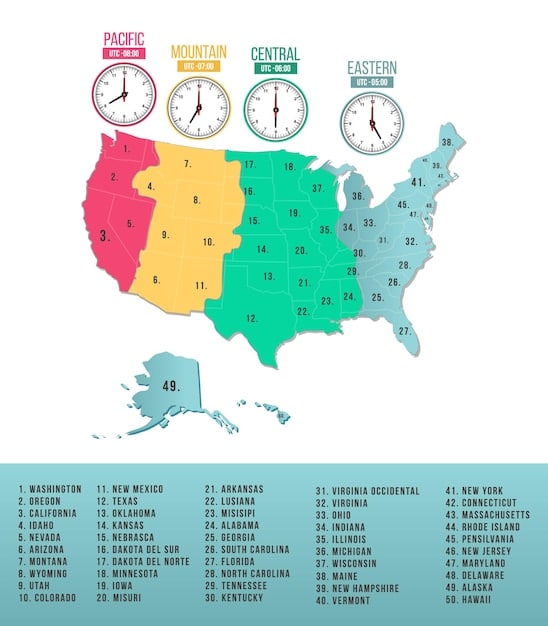Mastering Time Zone Management: A Digital Nomad’s US Guide

Anúncios
Mastering Time Zone Management: A Digital Nomad’s Guide to Working Across the US provides essential strategies for digital nomads to effectively navigate different time zones, ensuring productivity and seamless collaboration with clients and teams in various locations within the United States.
Navigating the complexities of time zones can be a significant challenge for digital nomads. But fear not! Mastering Time Zone Management: A Digital Nomad’s Guide to Working Across the US will equip you with the techniques and tools to conquer time zone differences and boost your productivity.
Anúncios
Understanding US Time Zones: A Quick Overview
The United States spans several time zones, making it crucial for digital nomads to understand these differences. From the East Coast to the West Coast, knowing the time zone boundaries is essential for scheduling meetings and managing deadlines effectively.
Let’s delve into the main time zones you’ll encounter while working as a digital nomad in the US.
Anúncios
Eastern Time Zone (ET)
The Eastern Time Zone covers states along the Atlantic coast, including New York, Florida, and Pennsylvania. If you’re working with clients or teams based in these states, keep in mind that they operate on ET.
Central Time Zone (CT)
Moving westward, the Central Time Zone includes states like Illinois, Texas, and Louisiana. Understanding the difference between ET and CT is vital for scheduling calls without causing confusion.

Here’s a quick rundown of common time zone challenges and how to address them:
- Scheduling Conflicts: Use scheduling tools to automatically convert times and find the best meeting times.
- Communication Delays: Set clear expectations for response times to avoid frustration.
- Reduced Overlap: Maximize the limited overlap by prioritizing critical tasks during these hours.
In conclusion, understanding the nuances of each time zone is the first step towards effective time zone management. By mastering these basics, you’ll be well-prepared to navigate the challenges of working across the US.
Essential Tools for Time Zone Management
To effectively manage time zones, digital nomads need to leverage the right tools. These tools can help automate scheduling, convert times, and ensure you’re always on the same page as your team and clients.
Here are some indispensable tools that can streamline your time zone management:
Scheduling Software
Scheduling software such as Calendly and Doodle Poll can significantly reduce the back-and-forth of finding suitable meeting times. These tools allow recipients to select available slots that automatically adjust to their time zone.
World Clock Apps
World clock apps, like Clockify and Every Time Zone, provide a quick overview of different time zones. These apps are beneficial for instantly checking the current time in various locations and planning your day accordingly.

Beyond these specific tools, consider implementing these strategies:
- Time Zone Converter Websites: Use online converters like World Time Buddy for quick conversions.
- Calendar Integrations: Sync your calendar with scheduling tools for seamless appointment setting.
- Team Communication Platforms: Utilize Slack or Microsoft Teams to coordinate tasks effectively.
In short, the right tools can transform time zone management from a headache to a seamless part of your daily routine. By integrating these tools into your workflow, you’ll stay organized and efficient, no matter where your work takes you.
Creating a Time Zone-Friendly Schedule
Crafting a work schedule that accommodates multiple time zones requires careful planning and flexibility. A well-structured schedule will allow you to maximize your productivity while minimizing the stress of working across different time zones.
Let’s examine how to build a schedule that works for you and your team.
Prioritize Overlap Hours
Identify the hours where your time zone overlaps with those of your clients and team members. Schedule important meetings and collaborative tasks during these times to ensure everyone can participate actively.
Batch Similar Tasks
Group similar tasks together and complete them during specific time blocks. For example, dedicate mornings to focused work and afternoons to meetings. This approach can enhance your focus and minimize context switching.
Consider these additional tips for a time zone-friendly schedule:
- Set Boundaries: Clearly define your working hours and communicate them to your team.
- Use Time Blocking: Allocate specific time blocks for different types of tasks.
- Incorporate Breaks: Schedule regular breaks to prevent burnout and maintain focus.
Ultimately, a flexible and well-managed schedule is your key to navigating the complexities of time zones. By implementing these strategies, you can create a productive and sustainable routine that works for you and your team.
Effective Communication Strategies
Communication is paramount when working across different time zones. Clear, concise, and proactive communication can prevent misunderstandings, reduce delays, and foster a strong working relationship.
Here are some strategies to enhance your communication across time zones:
Asynchronous Communication
Embrace asynchronous communication methods such as email, project management tools, and recorded video messages. These tools allow team members to access information at their convenience, without requiring immediate responses.
Establish Communication Guidelines
Set clear guidelines for response times, communication channels, and project updates. This helps manage expectations and ensures everyone knows how and when to communicate effectively.
To further improve your team’s communication, consider these practices:
- Document Everything: Keep detailed records of decisions, discussions, and project progress.
- Use Visual Aids: Utilize visuals such as charts, diagrams, and screen recordings to convey complex information.
- Over-Communicate: When in doubt, err on the side of providing too much information rather than too little.
In conclusion, effective communication strategies are essential for building trust and cohesion in remote teams. By implementing these practices, you can ensure seamless collaboration and minimize the challenges posed by different time zones.
Maintaining Work-Life Balance
Working as a digital nomad can blur the lines between work and personal life, making it crucial to establish and maintain a healthy work-life balance. This balance is essential for your well-being and long-term productivity.
Let’s explore how to achieve a sustainable balance when working across multiple time zones.
Set Clear Boundaries
Define your working hours and stick to them as much as possible. Communicate these boundaries to your team and clients to manage expectations and prevent overwork.
Schedule Personal Time
Just as you schedule work tasks, schedule personal activities such as exercise, hobbies, and social time. Treat these appointments as non-negotiable to ensure you prioritize your well-being.
Consider these additional tips for maintaining work-life balance:
- Disconnect Regularly: Take breaks throughout the day to step away from your computer and recharge.
- Create a Dedicated Workspace: Designate a specific area for work to help separate your professional and personal lives.
- Practice Self-Care: Engage in activities that promote relaxation and reduce stress, such as meditation or yoga.
In the end, preserving a healthy work-life balance is vital for your long-term success as a digital nomad. By implementing these strategies, you can protect your physical and mental health while enjoying the freedom and flexibility of your lifestyle.
Dealing with Jet Lag and Fatigue
Traveling frequently as a digital nomad can lead to jet lag and fatigue, which can significantly impact your productivity and well-being. Understanding how to manage these conditions is essential for maintaining peak performance.
Here are some strategies to mitigate the effects of jet lag and fatigue:
Adjust Your Sleep Schedule
Start adjusting your sleep schedule a few days before your trip to gradually align with the time zone of your destination. This can help minimize the shock to your body clock.
Stay Hydrated
Drink plenty of water during and after your travels to combat dehydration, which can exacerbate fatigue.
Here are more tips to help you combat jet lag and fatigue:
- Expose Yourself to Sunlight: Natural light helps regulate your circadian rhythm and can reduce the severity of jet lag.
- Avoid Alcohol and Caffeine: These substances can disrupt your sleep and worsen jet lag symptoms.
- Exercise Regularly: Physical activity can boost your energy levels and improve your overall well-being.
To summarize, effectively managing jet lag and fatigue is crucial for maintaining your health and productivity as a digital nomad. By following these strategies, you can minimize the negative effects of travel and stay energized and focused on your work.
| Key Point | Brief Description |
|---|---|
| ⏰ Understanding Time Zones | Know the US time zones (ET, CT, MT, PT) to schedule meetings effectively. |
| 🗓️ Scheduling Tools | Use tools like Calendly and World Time Buddy to manage appointments. |
| 🗣️ Communication Strategies | Implement clear communication guidelines for remote team collaboration. |
| 🧘 Work-Life Balance | Maintain a healthy balance by setting boundaries and scheduling personal time. |
Frequently Asked Questions
The main time zones in the US are Eastern Time (ET), Central Time (CT), Mountain Time (MT), and Pacific Time (PT). Understanding these zones is crucial for scheduling meetings and coordinating tasks across different locations.
Scheduling tools like Calendly and Doodle Poll automate the process of finding suitable meeting times. Recipients can select available slots that automatically adjust to their time zone, reducing confusion.
Effective strategies include asynchronous communication methods like email and project management tools, setting clear communication guidelines, documenting decisions, and over-communicating when in doubt to minimize misunderstandings.
Maintain a healthy balance by setting clear boundaries for working hours, scheduling personal time, creating a dedicated workspace, disconnecting regularly, and practicing self-care activities to reduce stress and prevent burnout.
Manage jet lag by adjusting your sleep schedule before traveling, staying hydrated, exposing yourself to sunlight, avoiding alcohol and caffeine, and exercising regularly to maintain energy levels and regulate your body clock.
Conclusion
In conclusion, mastering time zone management is essential for digital nomads working across the US. By understanding time zones, using the right tools, and implementing effective communication and scheduling strategies, you can enhance your productivity and maintain a healthy work-life balance, ultimately thriving in the digital nomad lifestyle.





